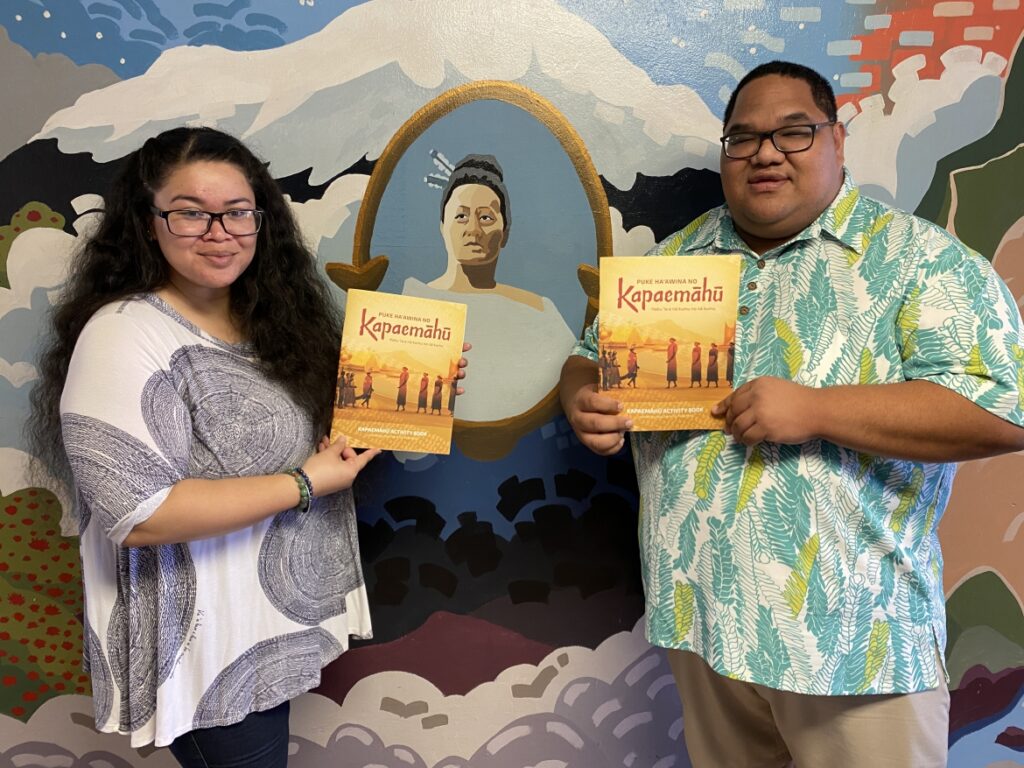Kamehameha Schools Kumu Create Dual-Language Curriculum for Kapaemahu
Kapalama Newsroom – November 2, 2022:
By kumu, for kumu. That is the guiding framework two Kamehameha Schools Kapālama kumu used to create a teaching curriculum about the mo‘olelo of Kapaemāhū, in partnership with Kanaeokana and Kanaka Pakipika.
The mo‘olelo, which Kanaka Pakipika brought to life in an award-winning animated short film, tells the story of four kahuna of dual male and female mind, heart and spirit (māhū) who brought the healing arts from Tahiti to Hawai‘i. When Kanaka Pakipika proposed creating a curriculum for students inspired by the film, KS’ Kealaiwikuamo‘o senior project manager Manuwai Peters, Kumu Kahanuola Solatorio KSK’10 and Kumu Kalehua Kawa‘a KSK’07 answered the call.
“There are so many things we can use as Hawaiians to create curriculum. Going out to kilo or watching a film and looking at it from an educational perspective, that’s Hawaiian culture-based education,” says Kumu Solatorio. “Our kūpuna were able to use the resources they had, whether a little bit or a lot and create amazing things with it.”
With input from a small focus group of K-12 kumu from schools across the state, Solatorio and Kawa‘a took the lead in producing a series of 11 ha‘awina to supplement the film. Kumu can customize the lessons for haumāna of all ages. Each one addresses a different theme from the Kapaemāhū film, including gender fluidity as told through Native Hawaiian understanding of māhū, wahi pana, ho‘olauna, mo‘olelo, ‘ōlelo Hawai‘i, Hawai‘i’s history and more. The curriculum, offered in ‘ōlelo Hawai‘i, English and dual-language, is available as printed workbooks and as digital and interactive PDFs.
“We know that Hawaiian culture-based education, which this [curriculum] represents, is something for all students,” says Peters. “It does have a special place for Native Hawaiian learners because HCBE is a decolonizing methodology that can rebuild and reawaken Native Hawaiian students into their rich past. We have a foundation of knowledge and history that has largely been pushed aside because of settler colonialism. This activity book provides educators with an opportunity to tap into this knowledge system and as such, to employ a decolonizing framework.”
In early October, Solatorio and Kawa‘a conducted workshops – both in ‘ōlelo Hawai‘i and English – with more than 30 kumu from public, charter and independent schools as well as parents and volunteers at Bishop Museum. Attendees received printed copies of Puke Ha‘awina no Kapaemāhū or the Kapaemāhū Activity Book.
“We love to provide and build things for students, for kumu to use to better the future of Hawai‘i for Hawai‘i,” says Kumu Kawa‘a. “It was beautiful to see the lessons [kumu] were thinking about as a result of the foundation we created.”[1]
Additional workshops for kumu to connect with this curriculum are currently being planned in communities throughout the islands, including on Kaua‘i on November 9. For more information about upcoming workshops or about the activity book, please e-mail kumu@kanaeokana.net.
Kumu can access and download the curriculum via Waihona here: https://waihona.net/#/resources/xhUkhFNPpQOAwZUi1wFg
Interested in learning more? Watch the award-winning Kapaemāhū animated film that inspired the curriculum here: https://vimeo.com/360633624/7929768d87
Full article here.
